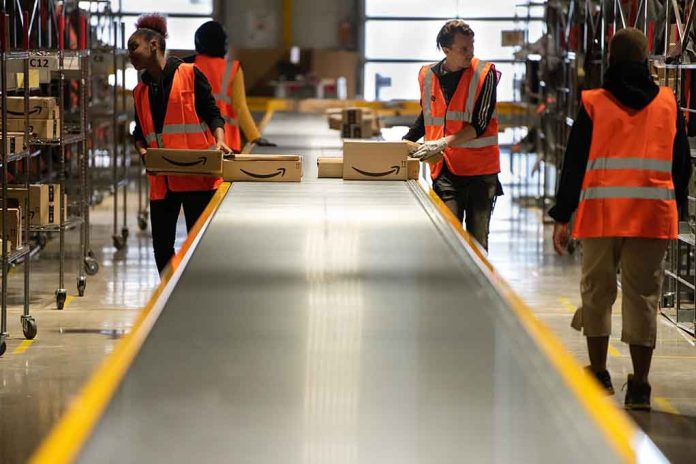
Chinese sellers on Amazon face an existential crisis as Trump’s tariffs soar to 125%, forcing them to choose between major price hikes or abandoning the American market altogether.
Key Takeaways
- Chinese sellers represent over 50% of Amazon’s marketplace and are now facing “unprecedented” tariff rates of 125% on imports to the US.
- Many sellers have already increased prices by up to 30%, with some projecting price hikes as high as 50% once current inventory depletes.
- The closure of the “de minimis loophole,” which previously allowed duty-free imports under $800, will further impact direct-from-China sellers.
- American manufacturers and sellers see a competitive advantage as the playing field levels against Chinese imports.
- Some Chinese businesses are pivoting to focus on European, Canadian, and Mexican markets to offset US losses.
Tariff Impact on Amazon’s Marketplace
The Trump administration’s aggressive trade policy against China has created a major disruption for Amazon’s seller ecosystem. With Chinese merchants making up more than half of Amazon’s third-party marketplace according to Marketplace Pulse, the new 125% tariffs threaten to fundamentally alter the platform’s competitive landscape. Wang Xin, who heads the Shenzhen Cross Border E-commerce Association representing 3,000 Amazon sellers, described the tariffs as an “unprecedented blow” to Chinese merchants who have built businesses around serving American consumers.
The scale of this challenge is substantial, as estimates suggest up to 70% of goods sold on Amazon are sourced from China. While Trump has temporarily reduced tariffs to 10% for most countries during a 90-day assessment period, Chinese imports remain targeted with the full 125% rate. This stark difference has left Chinese sellers scrambling to adapt their business models to survive in what has been their largest overseas market.
Chinese companies that sell products on Amazon are preparing to hike prices for the U.S. or quit that market due to President Donald Trump's unprecedented tariff hikes, sellers and the head of China's largest e-commerce association said. https://t.co/KDRuUTDY39 pic.twitter.com/xUp50aKfDU
— Reuters (@Reuters) April 10, 2025
Price Increases and Market Shifts
Chinese sellers are implementing various strategies to address the tariff challenge. Dave Fong, an Amazon seller based in China, has already raised prices by up to 30% on his products. More significantly, he plans to redirect his business focus away from the United States toward European, Canadian, and Mexican markets where tariff burdens are less severe. This trend of market diversification appears to be gaining momentum among Chinese sellers who see limited options for maintaining profitability in the American market.
Brian Miller, another seller affected by the tariffs, warns that consumers should expect even more dramatic price increases once current inventory stocks are depleted. He anticipates some products could see price hikes of up to 50% as the full impact of the tariffs works through supply chains. Amazon CEO Andy Jassy has acknowledged this reality, indicating that third-party sellers will likely need to “pass the cost on” to consumers, potentially affecting millions of American shoppers who have grown accustomed to Amazon’s competitive pricing.
Changing Competitive Landscape
The tariff situation creates both winners and losers in the Amazon marketplace. American-based sellers and manufacturers may find new competitive advantages as the price gap with Chinese competitors narrows or disappears. The closure of the “de minimis loophole,” which previously allowed duty-free imports under $800, further strengthens the position of domestic sellers against direct-from-China competition.
Some manufacturing has already shifted from China to countries like Vietnam, Mexico, and India, though industry experts note that many factories in these alternative locations remain Chinese-owned. Amazon itself is working to diversify its supply chain to mitigate tariff impacts, particularly for its own first-party brands. Jason Goldberg, chief commerce strategy officer at Publicis, suggests that in an environment of rising prices, “consumers are likely to have a preference for well-known, familiar brands,” which could benefit Amazon’s private label offerings over lesser-known third-party products.









